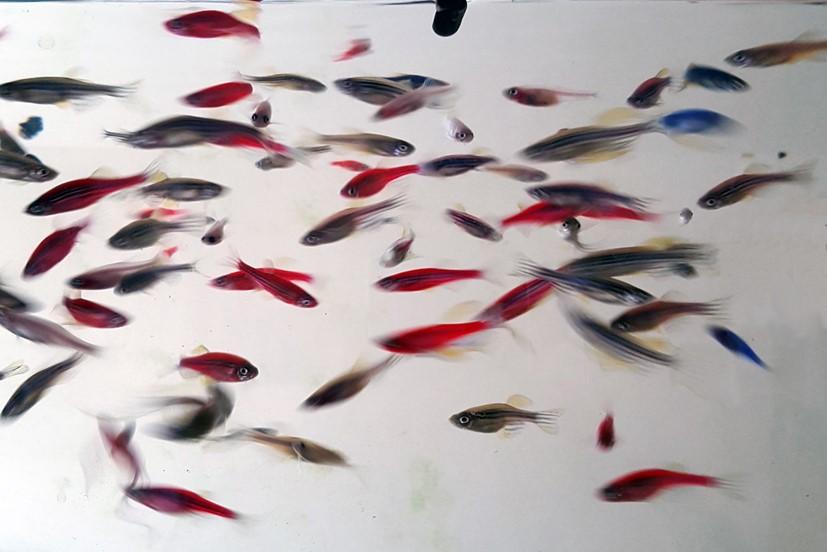Environmental exposure to nanoplastics in daily life is very common. Surprisingly, very few studies have attempted to quantify the effect of nanoplastic exposure on animal health and development until now.
Nanoplastics are extremely small plastic particles resulting from the degradation of plastic objects. Humans and animals are frequently exposed to both microplastics and nanoplastics through the inhalation of fibers that come from fabrics. Humans and animals are also exposed through the ingestion of water with plastic residues from filters, pipes, bottles and ingestion of contaminated foods, among other sources. Nanoplastics are the least studied form of plastic debris because of their very small size compared with microplastics.
Georgetown’s physics, chemistry and oncology departments, as well as the Lombardi Comprehensive Cancer Center’s shared zebrafish resource, are in the preliminary stages of an innovative study to understand how environmental exposure to nanoplastics could adversely affect animal health by studying their effects in zebrafish.
“Plastics tend to be pretty inert, so you would think, ‘It’s not going to hurt me,’ but anything in enough quantity is going to affect your physiology,” Edward Van Keuren, a professor in the physics department and the William and Karen Sonneborn chair for interdisciplinary collaboration, told the Hoya.
The project began through a long-standing collaboration at Georgetown between Christopher Albanese, a professor in the departments of oncology and pathology; Van Keuren from the physics department; and Sarah Stoll, a professor in the chemistry department.
The researchers have been working together to develop nanoparticles that can be used as magnetic resonance imaging (MRI) contrast agents. These contrast agents, or dyes, improve the quality of MRI images, which makes internal tissues easier to see. The ultimate goal for these improved contrast agents is to enhance cancer imaging abilities.
Stoll’s lab developed these magnetic cluster nanoparticles based on iron or manganese, and Van Keuren’s lab encapsulated the minerals into plastic polymers, which protected the clusters from their environment and made them stable in water. The magnetic cluster nanoparticle are nanoparticles that have magnetic properties and are often used in drug delivery,
The researchers realized they could use this MRI technology to study how nanoplastics affect animal health. They plan to attach a nanoplastic found in the environment, like polystyrene, a type of plastic that is often used in products such as egg cartons, to the surface of an MRI imaging cluster. The magnetic cluster would then deliver the nanoplastic, allowing researchers to analyze its effects in the body.
These scientists also reached out to Eric Glasgow, the director of the Animal Model Zebrafish Shared Resource at Georgetown, to begin work on studying the impact of nanoplastics in animals.
Zebrafish are excellent models for learning about human disease and development. They share 70% of the same genes as humans, and 84% of genes known to be associated with human genetic disease have a direct zebrafish counterpart. Zebrafish and humans also share much of the same fundamental anatomy.
“The last common ancestor between humans and zebrafish was an organism that already had a perfectly good heart, kidney, liver, circulatory system and brain. All of the things that make an animal tick,” Glasgow told The Hoya. “If you look at all of the molecular control behind making all those things, you can’t change it all that much.”
The research teams will use two methods to analyze how nanoplastics affect the zebrafish.
They first will utilize the MRI imaging clusters that are attached to the nanoplastic to visualize the localization of the nanoplastics inside the fish.
The researchers will then quantitatively analyze the amounts of nanoplastics using a technique called mass spectrometry. This technique is possible because of the incorporation of manganese and iron in the clusters
“We could take out a liver of a fish after it has been exposed to these nanoplastics for a long time and measure how much manganese is in there using mass spec. We can tell how many particles were in their environment over a certain time, and how that’s led to the accumulation of X number of particles,” Van Keuren said.
These strategies together allow the researchers to create a unique and compelling case for the localization of nanoplastics in zebrafish by combining qualitative visualization with quantitative analysis.
“Our materials have a couple of advantages. One is that we can do MRI imaging,” Van Keuren told The Hoya. “A lot of the work that’s out there is somewhat more qualitative. People were just trying to image the nanoplastics using fluorescence imaging, but we can track it a bit better.”
Future work will focus on investigating the path through the aquatic food chain of nanoplastics and health effects in Zebrafish at various stages of development.
“Almost all of the pathways that will be in use later in life are active during embryogenesis. So when you’re messing something up with embryogenesis, it points to some mechanism,” Glasgow said.
Glasgow said that he is confident the findings in these zebrafish studies will offer insight into human health.
“I can almost guarantee it’s going to translate very easily. If we see heart defects in the embryo, that’s likely something we would see in people,” said Dr. Glasgow.
The study hopefully will provide critical information for understanding the potential impact of these particles on human health and the health of our environment.
“It’s kind of scary from an environmental standpoint,” Glasgow said. “You always think of the plastic waste and plastic trash as stuff you see on the beach. But then when it breaks down, now it’s microplastics; it breaks down farther, now it’s nanoplastics. Now you can’t see it.”









